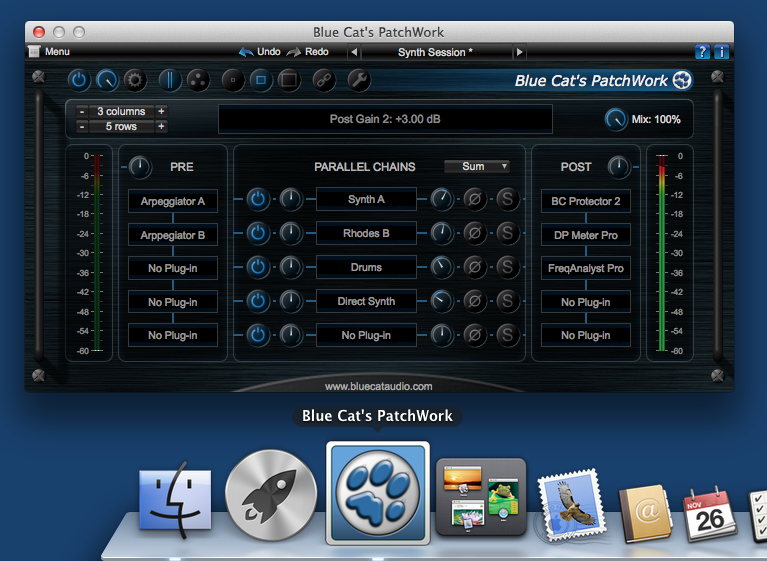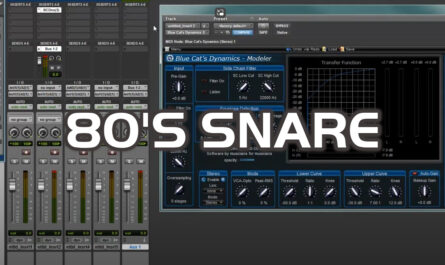Since the release of Blue Cat’s PatchWork 1.6 yesterday, we have been asked a couple of times what it is possible to do with the standalone version of the software.
So here is a brief overview and a few ideas about how Blue Cat’s PatchWork standalone host can be used! This is of course not exhaustive, so feel free to comment this post and tell us how YOU use it!
“Live” / Real Time Plug-In Host
The main purpose of Blue Cat’s PatchWork standalone is live usage: with an appropriate audio interface (aka sound card), it is capable to perform at low latencies as a real time audio processor or instrument: it can load and host third party audio plug-ins, so that you can use them quickly in real time.
PatchWork as a Virtual Instrument

If you load one or several virtual instruments plug-ins into Blue Cat’s PatchWork, you can use them with any MIDI controller connected to your PC or Mac. Hit a key on the keyboard and you will hear the result at the output the selected audio interface instantly. It is as simple as that: Blue Cat’s PatchWork can easily transform your computer into a musical instrument.
A bit more advanced, but still quite simple, you can also patch third party MIDI effects before your virtual instruments (arpegiators, MIDI filters, step sequencers…) and build your own “meta-instrument” that you can play with one or more MIDI controllers.
PatchWork as an Audio Processor
If your audio interface has inputs, you can just plug any instrument or microphone into it and process the sound in Blue Cat’s PatchWork, using your favorite audio plug-ins.

For example, plug your guitar into your audio interface and create your own multi effects processor using Blue Cat’s Patchwork and VST plug-ins. You can save and load any effect chain instantly using presets. You can even assign and control the parameters of inserted plug-ins with any MIDI controller (foot pedal, control surface) that is connected to your computer via MIDI: volume, distortion, delay time… All controlled with your feet if you want.
Don’t throw away your amplifier though: why not just plug your computer into it and PLAY IT LOUD?
PatchWork as One Man Band
As you have understood, you can mix both approaches and use audio inputs as well as virtual instruments or drums machine plug-ins all together inside Blue Cat’s PatchWork.
It looks like it’s time to start your one-man band: you can launch sequences, keep drum loops running in the background and play live altogether at the same time, all within the PatchWork Application! It will all be kept synchronized by the application (if using plug-ins that support it).
File Playback
You can also use Blue Cat’s PatchWork to play audio files and apply effects in real time, using an audio file player plug-in (Blue Cat’s Plug’n Script has a wav file player script for example). Insert the file player plug-in in the first slot, and apply your effects after it, in series or parallel:

Record Yourself!
Using (again) a plug-in able to record audio to file (For example, Blue Cat’s Plug’n Script has a wav file recording script that can be used for this purpose), you can record your performance to an audio file. Whether you are using virtual instruments or real instruments connected to the computer does not matter, you can just record everything at once in a single file.
That’s a very fast and easy way to record yourself without having to launch a full featured DAW and create audio and MIDI tracks for all instruments. Don’t lose your inspiration: play and record everything thru Blue Cat’s PatchWork, instantly!
Also, since you can place the recorder plug-in anywhere in the chain, you can either record the full performance at the end of the application, or just the incoming dry signal, so that it can be re-processed differently later.
PatchWork as a Standalone Analyzer

With our audio analysis plug-ins, Blue Cat’s PatchWork can be turned into a full-featured standalone audio analyzer: you can monitor and troubleshoot incoming signals in real time.
Prepare your Plug-Ins Setup
It is often more convenient to quickly launch Blue Cat’s PatchWork to create and test your effects chains rather than bring a full featured DAW into memory. Once you are done, just save the chains as a preset. These presets can be loaded later in the plug-in version of Blue Cat’s PatchWork (VST, AAX, Audio Unit or DirectX supported), right into your DAW of choice.
What About you?
That’s already a couple of ideas to take advantage of our new application, but there are probably lots of other ways to use it we have not even thought about… So please comment below and tell us more about what you use the PatchWork application or plug-in for!





I bought a late 2014 Mac Mini with pro tools 11 which uses 64 bit aax plugins. I had wave plugins running on a PC that were 32 bit. Can Blue Cat’s PatchWork solve my problem of incompatible plugins using pro tools 11.
Blue Cat’s PatchWork does not include a 32/64-bit bridge, so it will let you load only 64-bit plug-ins into Pro Tools 11. However on Mac you can also use SoundRadix’s 32Lives to bridge older 32-bit Audio Units and load the into PatchWork in PT11 (and we have partnered with SoundRadix to offer a bundle including both products with a special price).
You can use Voice Meeter Banana to send out audio using the LAN network and the recieve at another computer of your choice. It’s called VBAN in VMB.
Light weigth program with great powers.
I use blue cat to record thru plugins into protools via the mio console. Its great for di into amp sims.
Sounds great! Do you maybe have a screenshot of your setup to show others how this is possible?
Blue Cat Patchwork rocks! I was initially concerned about latency due to the fact that my main intention was to host 32 bit AU plugins (wave) in Pro Tools 11. It does work and there is latency compensation built-in. I am yet to here any delay / latency in a chain of 16 plugins! Great solution !
i’m trying to layer synths in blue cat patchwork h. I can’t get it to layer , it only plays one synth at a time. Am i doing something wrong?
To layer synths, you should add each synth to a different parallel chain (and activate the chain). If putting them in series, the latest synth will indeed win.
Is it possible to use it as a synth host in a multi-timbral setup?
Seems that all the parallel chains respond to the host midi port, is it possible to set a synth on a channel x on port y and another on channel w on port z for example and control them separately with different midi stream? (like a notation software or a live keyboard rig)
Is it also possible to route program change to program change enabled synths directly to change patches?
PatchWork will currently listen to all MIDI input ports, so there is no way to filter by MIDI ports at this point. However you can use different MIDI channels for each input and select a different channel for each synth in each chain.
PatchWork does not interpret program change messages to select programs for each sub-plugin. However if the hosted synth plug-in supports program change messages, using separate channels should work for you.
Hi there,
By loading multiple plugins in a BlueCat Patchwork Chain instead of loading each plugin individually, does this allow me to save CPU?
Actually, there should not be much difference.
Hi!
Is it possible to use Patchwork to effect the signal I am hearing?
Meaning using it as a standalone app, processing the audio I hear in real-time.
How would one have to configure Patchwork? Thank you
This is possible but usually requires a specific driver setup to do the routing. Are you on a Mac or Windows machine?
Windows. Got M-audio card 2 in, 2 out, official driver. Would I need something else?
And how can I set bluecat to work in such a way? Thank you
You will need a specific audio driver such as this one: http://vb-audio.pagesperso-orange.fr/Cable/. It will let you connect the output of an application to the input of another one (PatchWork in this case).
Hi I’m considering either Waves Multi Rack or Blue Cat Patchwork standalone to insert up to 16 channels from my Behringer X32 – is the the Patchwork standalone a comparable solution for this?
Not sure what this software can do, but while PatchWork is able to process up to 16 channels, it is mainly designed as a channel strip. So using plug-ins on different channels work but it is not as convenient as it it were a virtual mixer.
Using Battery 4 Drum VST wondering if Patchwork will route each instrument seperatley to multiple buses in pro tools 8. I noticed that it will only patch to 1 bus at a time. Is there a work around
Have you seen this tutorial to use Blue Cat’s Patchwork aux busses in Pro Tools? https://www.pro-tools-expert.com/home-page/2015/7/19/using-bfd-eco-with-blue-cats-patchwork-in-pro-tools-11
When I use my SL88 keyboard controller, another midi controller (Behringer Touch X mini) wont work with Blue Cat’s Patchwork. So how can I controll Blue Cat’s Patchwork with two or more midi controllers?
You can use as many controllers as you want with PatchWork: it will use all available MIDI inputs. You need however to make sure all the controllers are connected and active before launching PatchWork.
I’m shopping for a Vst Host for playing vst instruments live. Does PW allow me to do multiple keyboard split for playing 2 or more instruments separated in different regions of the keyboard, instead of just layring them? Also does it do midi transpose for each instrument?
PatchWork does not include MIDI processing routines. You can however use any MIDI VST plug-in to perform keyboard splitting and transposition before the events reach the synths. To do this just place the MIDI plug-ins before the synths and select the appropriate MIDI ports so that the MIDI plug-ins are placed between the host and the synth. As an example, Blue Cat’s Plug’n Script has a couple of MIDI scripts that can do exactly what you are looking for.
Images like these are VERY misleading. You show arpeggiators, then they should be native to the software… most anything in a promotional image (with rare exception should). Please create a few reasonable MIDI add-ons to go with this… An octave transposer, arpeggiator, etc. etc.
MIDI built-in plug-ins would indeed be nice. There are already quite a few third party available on the market though.